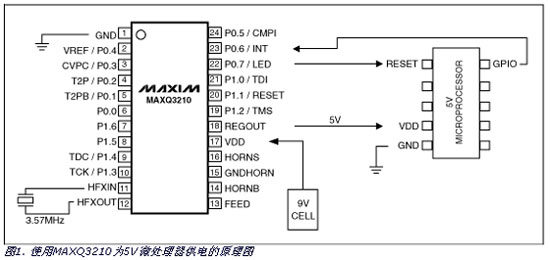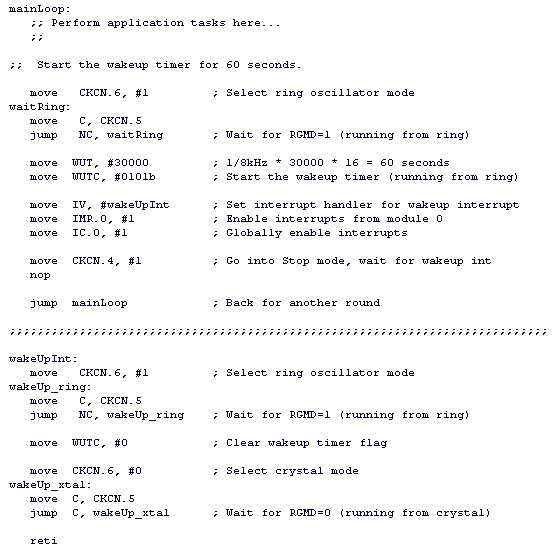Overview A low-power microcontroller can be used instead of a dedicated microprocessor supervisory circuit to support these various tasks. Depending on its performance, a microcontroller can provide services supported by multiple devices, and because the monitoring functions can be programmed through software, there is great flexibility. This application note describes a typical microprocessor monitoring function using the MAXQ3210 low-power microcontroller with piezo speaker driver, voltage regulator, and comparator. The MAXQ3210 implements a variety of functions in a stand-alone configuration, powered by a 9V battery, and its internal low-speed oscillator eliminates the need for an external clock circuit. The MAXQ3210's small package size (24-pin TSSOP) makes it ideal for traditional designs or other space-constrained products. Battery powered portable system The MAXQ3210 includes a linear regulator from 9V to 5V conversion, making it ideal for portable, battery-powered microcontrollers or microprocessor systems. The MAXQ3210's low battery voltage detection allows the system to provide intelligent management at low battery voltages. When working with a 5V microprocessor, the MAXQ3210 can be used directly as long as the supply current required by the microprocessor is within the power supply range of the MAXQ3210 linear regulator (a maximum of approximately 50mA, see the MAXQ3210 data sheet for details). The output pin REGOUT (Figure 1) powers the microprocessor. When the microprocessor current is very low, the MAXQ3210's port pins can also be set to a standard high output (PD = 1, PO = 1) to power the microprocessor directly. Each port provides at least 4mA of current with a voltage drop of less than 0.4V. As long as the sum of the currents of all port pins does not exceed the maximum rating (approximately 25mA, see the data sheet for details), multiple port pins can be connected together to enhance the supply current. When the port is used to power the microprocessor directly, the MAXQ321 can turn the microprocessor's power on and off as needed to extend battery life. Note: When using REGOUT to power the microprocessor, the power supply can still be turned on and off under the control of the MAXQ3210, but requires an external FET or other switching device. When the supported microprocessor requires a terminal voltage other than 5V (eg, 3V, 2.5V, or Others), the REGOUT output of the MAXQ3210 can generate the voltage required by the microprocessor through a linear regulator. By using a linear regulator with an enable/disable input, the MAXQ321 can still completely shut down the microprocessor's power supply to extend battery life.
The MAXQ3210 operates at very low current conditions to save energy when critically designed for battery life and total system sink current. Not only does the MAXQ3210 feature a full-featured MAXQ? power-managed mode (divide, PMM1, and STOP modes), it saves energy and includes an 8kHz oscillator that can be used as a very low-power clock source. At power-up, if there is no external crystal or high frequency clock source, the MAXQ3210 will run on an 8kHz oscillator, reducing its operating current to the microamps. Because the response time requirements are not critical, the MAXQ3210 can perform the monitoring functions in this application note even when operating at 8kHz. Reset and power monitoring The MAXQ3210 provides a power-on reset (POR) and undervoltage detection that allows it to exit the reset state when the power supply is stable. Undervoltage detection allows the microcontroller to resume operation from a power supply drop condition. The MAXQ3210 also provides similar POR and undervoltage detection for microprocessors without power monitoring. Connecting one port of the MAXQ3210 to the external RESET pin of the microprocessor causes the MAXQ3210 to reset the microprocessor when the power supply is below the threshold setting and to bring the microprocessor out of reset when the power supply returns to normal. If the microprocessor is operating from a 5V supply, the MAXQ3210 will reset the microprocessor as long as the MAXQ3210 is in a POR or undervoltage condition. If the microprocessor is operating at a lower supply voltage (for example, 3.3V), the analog comparator of the MAXQ3210 can compare the power supply of the microprocessor to any voltage on the VREF pin (up to 3.5V) (for analog comparators) For details, please refer to the MAXQ3210 data sheet). When the microprocessor's power supply drops below the reference voltage, the comparator will generate an interrupt to the MAXQ3210, reset the microprocessor, and remain in reset until the power supply returns to normal. Because all functions are implemented in software, the time interval for the microprocessor to recover from power to exit reset can be set to any time period. If the system has multiple power supplies or needs to be powered up in a specific order, the MAXQ3210 acts as a power-up timer that controls the power-up process of the device in the specified delay time sequence for each action. Add an external reset button to the system to initialize the reset sequence. Connecting the reset button to a port on the MAXQ3210 allows the MAXQ3210 to perform a software-based debounce and generate a width-programmable reset pulse in response to a key reset. Add wakeup timer In portable battery-powered systems, saving power and battery life is the key to design. To maintain low current consumption, such systems typically operate as low voltage as possible. The system wakes up periodically (or at the request of a user button) to take measurements or run other tasks and then returns to sleep. For devices that are not working, it is best to turn off their power supply. The MAXQ3210 provides a long-cycle wake-up timer to help save power. A wake-up timer that operates with an 8kHz ring oscillator can be set to put the MAXQ3210 into a low-power state-stop mode and automatically wake up after a preset time interval of up to 2 minutes. After exiting Stop mode, the MAXQ3210 wakes up on demand or powers up other devices in the system. The following MAXQ3210 program code demonstrates how to enter stop mode and then automatically wakes up after 60 seconds.
Connect a port on the MAXQ3210 to the microprocessor to inform it that it is ready to power down. After the MAXQ3210 signals a power outage, the microprocessor immediately enters a low-power stop mode or waits for a power-off depending on the task being performed. When the MAXQ3210 wakes up from Stop mode, it either powers up the microprocessor (if the microprocessor is completely shut down), or it can use an external interrupt or similar mechanism to signal the microprocessor to wake up from a low-power state. Add watchdog reset As with the wake-up timing of the MAXQ3210, the microcontroller's built-in watchdog reset circuit can be extended to an external hardware watchdog reset circuit of the microprocessor. In the MAXQ3210, the watchdog acts as a safety device to prevent run-out of programs when transients are disturbed. Once the watchdog timer is enabled, it must be reset by periodically setting a register bit. If the MAXQ3210 stops setting the register bit and the timer overflows, the watchdog will automatically reset the MAXQ3210. This automatic reset returns the MAXQ3210 to a known starting state and restarts the run. Extending the MAXQ3210's watchdog reset to the microprocessor requires only two connections: one port of the microcontroller to the external RESET of the microprocessor; one port of the microprocessor back to the MAXQ3210 port. The MAXQ3210 automatically enables the watchdog to reset the watchdog whenever it receives a signal from the microprocessor. The microprocessor is responsible for periodically triggering this pin to prevent the MAXQ3210's watchdog from timing out and the timeout period is programmable (see the MAXQ3210 User's Guide Supplement for details.) As an external watchdog for the microprocessor, the MAXQ3210 sets an interrupt when the watchdog timeout occurs. If the watchdog times out, it means that the microprocessor failed to trigger the microcontroller's port in time, and the microcontroller needs to be reset. The MAXQ3210 responds to the watchdog interrupt, restarts the watchdog, resets the microprocessor via the external RESET pin, and resumes a loop. Level and interface In the monitored state, the I/O levels of the two devices must be considered when communicating between the MAXQ3210 and the microprocessor. If both devices are operating at 5V, the port pins can usually be connected directly, so be sure to refer to the device data sheet. The MAXQ3210 output signal can also be directly connected to a low-voltage microprocessor (such as a 3.6V device). If the microprocessor pin contains a protection diode, the 5V output of the MAXQ3210 can be directly connected to the low voltage pin through a current limiting resistor. You can also choose to use an open-drain connection method: a pull-up resistor is connected between the two pins to connect to the low-voltage microprocessor, and the MAXQ3210's port is forced down (PD = 1, PO = 0) or tri-stated ( PD = 0, PO = 0) mode. The input of the MAXQ3210 driven by a low-voltage microprocessor pin also requires careful operation because the low-voltage microprocessor cannot drive its port pins to a high enough level to set the MAXQ3210's registers. If only one input is required (Figure 1), the low voltage signal can be connected to the analog comparator of the MAXQ3210. Other possible methods are to use an external pull-down FET with an open-drain configuration, or a level shifter such as the MAX3370. For more discussion on this issue, please refer to application note 3007, Logic Level Translation. in conclusion The small size, battery-powered, and stand-alone operation of the MAXQ3210 make it ideal for programmable microprocessor monitoring. Several useful power-saving modes and power-monitoring features make it easy to monitor the microprocessor, making the MAXQ3210 the core of extended battery life through software configuration, making it ideal for portable battery-powered products. | ||
:
Others
1. Hardware and electrical products: Hand Tools, power tools, cutting tools, measuring tools and abrasives, fasteners and seals, material handling, storage, packaging, and workshop office supplies, electrical products, testing instruments and meters, motors, bearings and belts, lighting;
2, hand tools: toolbox/package; Van; The toolkit. Portable toolbox; Kit; Wrench; Adjustable spanner; Open spanner; Dual-use spanner; Plum spanner; Ratchet wrench;
3, set insulation tools: pipe pliers; Pipe vise; Chain pipe tongs; Plastic hard tube cutter; Wire-setting tools; Set of tube tools; Set of silk machine; Metal pipe cutter; Hydraulic pipe bender;
4, power tools: drill; Gouge. Screwdriver head and sleeve; Openings for; Curve Saw Blade; Circular saw blade. Saber saw blade; Slice for grinding machine; Grinding tablets for grinding machines; Diamond cutting piece; Woodworking tools;
5. Cutting tools, measuring tools and grinding tools: twist drill; Center drill; Silk hammer; Die; Vertical milling cutter. Slotting cutter;
Drill bit,measure tape,cable ties,hammer drill
Behappy Crafts (suzhou)Co.,Ltd , https://www.behappyindustry.com

